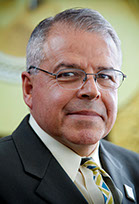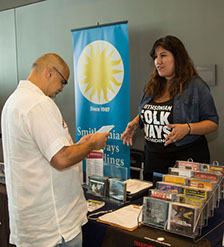
Feliz Cumpleaños Smithsonian
ABOUT US |
As the Smithsonian Latino Center (SLC) marked its 20th anniversary, Eduardo Diaz, its director since 2008, cited the Latino Curatorial Initiative as its most impactful accomplishment.
“Placing Latinx context experts at the different Smithsonian museums and research centers begins the process of  transforming the Smithsonian Institution’s Latino focus in exhibitions and online content. Without them, there would be a lack of first voices in exhibitions and online content. This is a best museum practice,” he said. “It puts teeth in diversity efforts.”
transforming the Smithsonian Institution’s Latino focus in exhibitions and online content. Without them, there would be a lack of first voices in exhibitions and online content. This is a best museum practice,” he said. “It puts teeth in diversity efforts.”
As a result of that initiative, there are Latino curators, to list just a few, at the National Museum of American History, National Portrait Gallery and the new National Museum of African American History and Culture. Since the program started in 2010, it has already been the catalyst for 21 exhibitions, 49 publications and over 300 acquisitions and new collections. Currently on view at the Smithsonian American Art Museum through March 18 is Tamayo: The New York Years, the first exhibition to explore the influences between Mexican modernist Rufino Tamayo and the American art world from the late 1920s through the 1940s. The exhibition was curated by E. Carmen Ramos, the museum’s deputy chief curator and curator of Latino art. at the Smithsonian American Art Museum.
The curatorial initiative complements a long-running Latino museum studies program, now known at the Smithsonian Institute for Interpreting and representing Latino Cultures. This program has fostered diversity within the museum field through a five- to six-week intensive seminar featuring education and curatorial workshops, behind-the-scenes tours, networking and a practicum. Fellows engage with Latino content experts around the Smithsonian and with scholars and professionals at other cultural institutions. Program participants have become part of a diverse network that is re-shaping the field of Latino and Museum Studies at such institutions as the Metropolitan Museum of Art, Berklee College of Music, National Park Service, Museum of Modern Art, and Stanford University.
Both the curatorial initiative and museum studies program have underpinned the SLC’s programs over the last 20 years, notably exhibitions in Washington, D.C. and around the country, the Latino Art Now conference, and the Latino Virtual Museum and Digital Collection. Just as important, however, they are forward looking initiatives.
years, notably exhibitions in Washington, D.C. and around the country, the Latino Art Now conference, and the Latino Virtual Museum and Digital Collection. Just as important, however, they are forward looking initiatives.
So, what does the future hold for the Smithsonian Latino Center? Diaz pointed to the establishment of a Latino Gallery on the National Mall as “the biggest goal on our plate.” The target date for that gallery has slipped to 2020. One challenge is identifying a suitable location. The historic Arts & Industries building, the second oldest in the Smithsonian, is one oft-mentioned option, even though it poses some structural problems, as are a couple of other sites. Diaz says he hopes to have a decision soon. To operate and program the gallery, substantial fundraising will be necessary, and Diaz expressed optimism that he has a “good shot at a lead donor.
In the meantime, planning is underway for the Latino gallery’s inaugural exhibition, wherever it may be located. One possible subject for the show is immigration; the center has already solicited curatorial proposals for an exhibition tentatively titled Making Home: Latino Stories of Community and Belonging. Other possible exhibition topics that Diaz listed are the early Latino communities in the United States, the Spanish-American War of 1898 and its aftermath, and the Chicano civil rights movement.
Also in the works is an exhibition on the legacies of indigenous communities in the Caribbean, among them the Taínos, who inhabited what is now the Dominican Republic, Haiti, Cuba and Jamaica. It is slated to open in mid-2018 at the National Museum of the American Indian’s George Gustav Heye Center in New York City, where as much as a quarter of the population has roots in the islands of the Caribbean and mainland countries surrounding it.
The exhibition grows out of SLC’s Caribbean Indigenous Legacies Project, a research effort started in 2011 by SLC, the National Museum of the American Indian and the National Museum of Natural History to document indigenous communities in the Caribbean as well as the cultural and historical legacies of native peoples across the region.
John Coppola